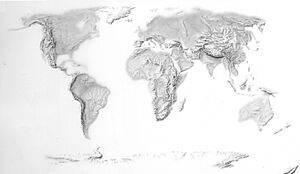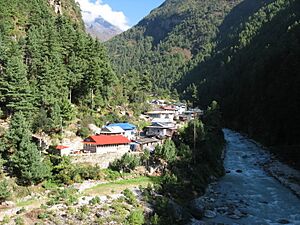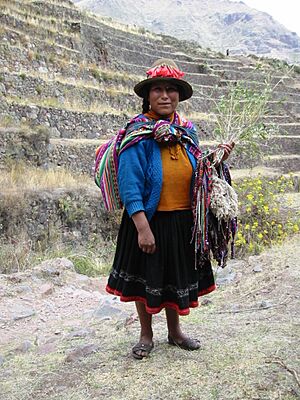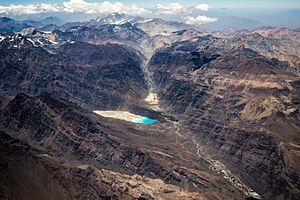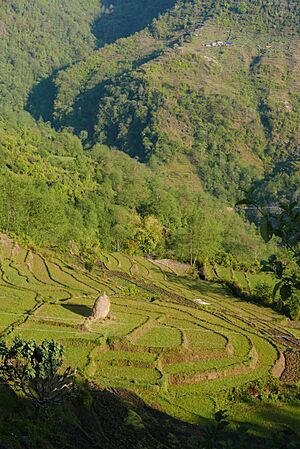Hill people facts for kids
Hill people or mountain people are general terms for people who live in hilly and mountainous areas. These areas include rugged land higher than 300 meters (about 980 feet) and all land (even flat areas like plateaus) higher than 2,500 meters (about 8,200 feet).
Life in the mountains can be tough. The weather often changes quickly, with big temperature drops between day and night. Strong winds, melting snow, and rain can cause the soil to wash away, leaving it thin and not very fertile.
People have lived in mountains for thousands of years. At first, they hunted and gathered food. Later, they became farmers and raised animals. Mountain communities are often isolated, meaning they are far from other places. This has led to many different cultures and languages developing.
Today, about 720 million people, or 12% of the world's population, live in mountain regions. Many of these communities face challenges, like not having enough food or good healthcare. They often rely on growing crops, raising animals, and using forest products. In richer countries, mountain people are usually well-off, and mountains are popular for tourism and outdoor fun. Mining has also been a big part of mountain life for a very long time.
In some parts of the world, young men from mountain communities go to work in cities or other countries. They send money home to help their families. Even though most mountain people live in the countryside, some live in big cities like Mexico City, which has about 21 million people. These cities attract people from rural mountain areas who are looking for work. Smaller mountain cities often feel more connected to the mountain culture and economy.
Contents
History of Mountain Living
The story of hill people goes back a very long time, even before the Halaf culture. It's thought that mountain people played a key role in sharing knowledge and culture. They helped restart civilization after local societies sometimes collapsed.
Where Do Hill People Live?
Experts classify mountain regions to understand them better. The World Conservation Monitoring Centre (WCMC) includes both hills and mountains in its definition. About 22% of the world's land, or 29 million square kilometers (about 11 million square miles), is considered a mountain region. About half of this land is below 1,000 meters (about 3,300 feet).
Land is called a mountain region if it's at least 300 meters (about 980 feet) above sea level and is rugged. However, flat plateaus and wide valleys below 2,500 meters (about 8,200 feet) are not counted as mountain regions. All land above 2,500 meters is classified as mountain, even if it's flat. This makes up 20% of all mountain areas. The Food and Agriculture Organization (FAO) of the United Nations uses this same way of classifying mountains.
Mountain Environments
Mountain environments are different depending on where they are on Earth and how close they are to the coast. The side of a mountain facing the wind usually gets more rain than the sheltered side. Mountain environments can be very harsh, especially in the cold, high-up areas above the tree line.
Only about 3% of the world's best farmland is found in mountain regions. Near the equator, temperatures on lower mountain slopes are often high all year, with lots of rain. Higher up and away from the tropics, temperatures can get very hot during the day and then drop sharply at night.
Strong winds are common, along with frequent freezing and thawing at higher levels. Snow, sleet, and heavy rain in some areas cause constant erosion. The thin soils on mountain slopes don't hold water well, so only plants that can handle dry conditions grow there. These plants are often low to the ground and have roots that spread out. If this plant cover is removed for farming, roads, or too much grazing, the soil can quickly wash away.
People have both adapted to mountain conditions and changed them. For example, farmers often use terraces (flat steps cut into the hillside) to hold soil and water. Plowing along the curves of the land also helps keep the soil stable. However, human activities have sometimes harmed mountain environments, reducing the number of different plants and animals.
Almost 28% of the world's forests grow on mountains. Forests are important for controlling water flow and providing wood for fuel and building. Before people arrived, most mountains in warm and mild climates would have been covered in forests up to the tree line. Cutting down trees is not new; it started 3,000 years ago in China. Mountain forests around the Mediterranean Sea and in Britain were cleared 1,500 years ago. More recently, China and Europe have tried to replant mountain forests to reduce flooding and erosion.
The effects of climate change on mountain environments are still being studied, but mountains seem to be more sensitive than flatlands. As temperatures rise, ecosystems at higher elevations will be forced to move further up the mountains, shrinking in size and eventually disappearing. This creates challenges like environmental stress and changes in rainfall. It's hard to know how well mountain people will adapt to these changes in the resources they depend on.
People of the Mountains
Amazing Diversity
People have lived in mountain regions for thousands of years. Some may have gone there to escape danger or changing weather. Others might have moved in search of food. Newcomers settled and built successful farming communities. Streams, rivers, and lakes in valleys provide water for farming and homes, making these areas good places to settle. The water could also power mills to process grain. More recently, these waterways are used for hydroelectric plants, which provide electricity but can disrupt local life.
In the past, it was hard to travel between mountain valleys. This isolation helped mountain communities develop many different cultures. Nearby communities might have different languages, traditions, clothing, food, and ways of making a living. You can see this in the Andes mountains and the western mountains of Canada. In the central Karakoram mountains, people speak Shina, Urdu, Waki, and Burushaski. Many different dialects of French, German, Italian, and Romansh are spoken in the Alps. The rugged mountains of Papua New Guinea have fertile valleys with mild climates. People there farm using traditional methods. The island's 7.6 million people speak almost 1,300 languages, and many are spoken by only a few hundred people.
Mountain cultural groups are often minorities within their countries, even if they are the majority in their specific region. This is true for the Tibetans, Naxi, Miao, Yi, and Uyghurs in China. It's also true for the Kurds in northern Iraq and eastern Turkey, the Amhars in Ethiopia, and the Quechua and Aymara in the Andes. Mountain people are often treated as less important in politics and the economy. Isolated mountain regions have even been used as hiding places by rebel groups.
While mountain areas are more isolated than flat lands, the difference in how many people live far from roads isn't as big as you might think. For example, in Ethiopia, 50% of mountain people and 40% of non-mountain people live more than 5 kilometers (about 3 miles) from a road. Mountain people often value land for farming more than easy travel to distant places. However, the lack of roads can sometimes feel like unfair treatment.
Life Today
Today, new ways of transport and communication are bringing goods, services, and information to even the most remote mountain areas. Mountain communities are becoming more connected to the rest of the world.
In 2003, the Food and Agriculture Organization estimated that about 720 million people, or 12% of the world's population, live in mountains. Only about 10% of these live in developed countries. About half of all mountain people are in Asia, and there are many growing populations in South and Central America. Most mountain people (70%) live below 1,500 meters (about 4,900 feet). A very small number of people in the Himalayas and the Andes live permanently at elevations over 4,500 meters (about 14,800 feet).
The countries with the most mountain people are Bhutan (89%), Rwanda (75%), Lesotho (73%), Armenia (70%), Guatemala (64%), Costa Rica (63%), and Yemen (61%).
About 70% of mountain people live in rural areas and rely on farming, fishing, and collecting things from local forests. Other people who live in the mountains include miners, loggers, and construction workers who move from place to place. Better roads mean these workers can live in a mountain community even if their job is some distance away. In Japan, Europe, and the eastern United States, traditional farming and forestry are decreasing in mountain areas.
Outside of Europe and Japan, the number of people in mountains is growing. Mountains are used as safe places, sources of minerals, and for tourism, farming, and raising animals. In the last 400 years, people moving into mountain areas in Africa, Australia, New Zealand, South America, Canada, and the Western United States have caused steady population growth. Some people, like the Talysh people in Iran, still live in the mountains.
How Bodies Adapt
Many people who live at high elevations grow slowly and have smaller bodies. This might help them need less energy and deal with low oxygen, cold, and hard work. People who have lived at high elevations for a long time often have larger lungs and hearts, more hemoglobin in their blood (which carries oxygen), and shorter arms and legs.
Studies in Peru show that people born at high elevations and lowlanders who moved there as young children have similar abilities to use oxygen. However, people who moved to high elevations as teenagers or adults had less ability to use oxygen. While genetics are important, there's no strong proof yet that genes are the main reason people adapt to high altitudes.
People in tropical high mountains get more sunlight than lowlanders. They also have to deal with bigger temperature changes between day and night. Seasonal weather means there are times of low and high activity, and times when food is scarce or plentiful. Unpredictable droughts, very cold periods, and plant or animal diseases make food availability uncertain. About 245 million mountain people are thought to be at risk of not having enough food. Most of these (87%) live below 2,500 meters (about 8,200 feet).
Water boils at lower temperatures at higher altitudes. This means it takes longer to cook food and needs more water and fuel. Gathering fuel also takes energy. Compared to people living in flatter areas, mountain people often suffer more from not getting enough food or important vitamins and minerals. They also have more breathing problems caused by the harsh climate and smoke in their homes during cold periods. These issues are made worse by not having good access to healthcare.
Working in the Mountains
How Land is Used
In mountain regions of developing countries, land is used in different ways:
| Land type | How it's used |
|---|---|
| Barren land (empty, rocky) | 26% is mostly barren |
| Protected areas | 9% is protected |
| Forests | 9% is mainly closed forest |
| Grazing land (for animals) | 41% is grazing land with some crops, forests, and barren land. 3% is mainly grazing. |
| Cropland (for farming) | 1% is mainly cropland |
| Mixed use | 11% is a mix of forest, grazing, and cropland |
About 17% of mountain people grow crops or combine crop, livestock, and tree farming. 19% live off barren land, protected areas, and dense forests. 44% of mountain land is used for grazing animals, and 64% of rural mountain people live there. The growing mountain population in developing countries is causing serious environmental problems in forests and grazing lands. Some forest or grazing land could be turned into farmland, but 78% of it isn't suitable for that.
From Hunting to Farming
Long ago, Paleolithic hunters and gatherers followed mountain animals as they moved between summer and winter pastures. They also fished, collected edible plants, and used wood for fires and shelter. Some groups, like the Dayaks of Kalimantan, still live a traditional hunting and gathering life, though they face pressure from the outside world.
Later, people who settled in the mountains combined hunting, gathering, farming, and raising animals. Most families did all these things. As jobs became more specialized, families did fewer activities, but there were more different jobs in the community. This change sped up in the last 400 years because of the industrial revolution and colonialism. People started focusing on selling things like furs and minerals, and more recently, tourism grew. During this time, many Han Chinese settlers moved to mountain areas in southwest and west China. European settlers moved into South and North America. Local people were often forced to work in commercial farming and mining. This change was not always good and harmed many traditional mountain communities.
Many important crops like maize, millet, potatoes, tomatoes, and wheat first came from mountain regions. So did tea, coffee, and quinoa. Crops grown in southern Switzerland, the Peruvian Andes, and the Central Nepal Himalayas are very similar. At low elevations, all three regions grow fruits. At middle elevations, they grow grains like barley and wheat, and maize and rice in the Andes and Himalayas. Higher up, they grow root vegetables like potatoes, then forests, and then pastures for sheep, cattle, goats, and in Peru for camelids.
The people of the Andes use a system called "vertical control." This means groups of people use family ties and other ways to access resources from different elevations. This allows them to get a variety of crops and animals, which is safer than relying on just one thing. The volcanic mountain region of Java supports many people who use the rich soils and different ecological zones based on altitude. They accept the risk of dangerous volcanic eruptions.
Near the equator, the sun is almost directly overhead all year, so the direction a slope faces doesn't matter much. Further away, the amount of sunlight varies a lot. In the Alps, south-facing slopes are preferred for homes and farming, while north-facing slopes are used for forests and ski resorts. In mountain regions with seasons, like Europe, North America, the southern Andes, and most of the Himalayas, high pastures can only be used in the summer. People work in the lower forest areas during the winter. Closer to the equator, in the central Andes, East Africa, and Southeast Asia, there might be less seasonal change. Permanent settlements as high as 4,000 meters (about 13,000 feet) are possible, with economies based on herding and cold-resistant grains and root vegetables.
When transportation improved, it became possible to grow crops like carrots, cabbage, beans, garlic, and apples to sell in distant markets, not just for local use. In Africa, there's a lot of pressure on mid-elevation environments from commercial and subsistence farming. Fast population growth in East Africa is mainly in the fertile farmlands of the mountain regions. While people now value large predators like bears, wolves, and snow leopards in the mountains, local people often don't agree. This is because these wild animals prey on their livestock and crops.
Mining for Resources
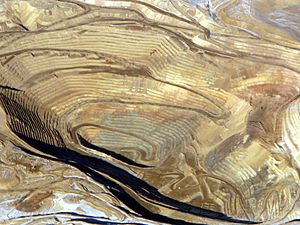
Mining has always been a big part of mountain economies. People have looked for precious stones, metal ores, coal, and salt in the mountains of Europe and the Americas for centuries. In many places, quarries for rock, gravel, and sand are also important for the economy. In North America, coal mining in the Appalachians and metal mining in the western mountains led to many settlements growing between 1850 and 1930. Many of these were abandoned during the Great Depression, but mining is still important in the Americas' mountain economies. Even though mountain mining has a long history, local communities often don't like mining companies using their shared lands and causing environmental damage.
So far, there hasn't been much mining in the Hindu Kush, Karakoram, and Himalayas, but this might change in the future.
Moving Around
Many mountain people in developing countries are poor. They rely on limited food resources from farming or animals. They might also work part-time in forestry, mining, or service jobs. In the past, Gurkhas, Swiss, and Scottish highlanders worked as soldiers in other countries. Today, many people from South Asian mountains work in countries like the Gulf States and send money home. Men in the Andes often find seasonal work on lowland farms and oil fields, or work in developed countries like Spain. This creates a fragile economy where older people, women, and children who stay behind depend on the money sent home by the men. The situation in Europe and North America used to be similar, but with better transportation today, mountain people are generally quite well-off.
Some people, like the Gaddis and Gurjars in the western Himalayas, are nomadic pastoralists. This means they move their animals seasonally through the mountains. North American hunters and gatherers used to follow a similar pattern. Other people who live in developed country mountains for part of the year include young people who work in ski resorts or plant trees. Also, people with second homes use them for recreation. In South and East Asia, many poor workers from the lowlands do construction, road building, and road maintenance. The Sherpas near Mount Everest can often afford to hire Rai workers for most manual tasks.
Mountain Cities
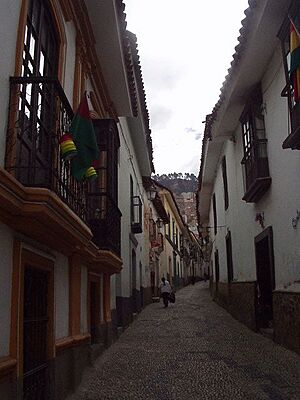
Almost 30% of mountain people live in towns or cities. The biggest cities are often on the edges of mountains or on high plateaus. Examples of large cities (over 1 million people) in or near mountains in Latin America include Mexico City at 2,250 meters (about 7,380 feet) with about 21 million people, Bogotá at 2,650 meters (about 8,700 feet), Quito at 2,850 meters (about 9,350 feet), La Paz at 3,500 to 3,800 meters (about 11,500 to 12,500 feet), Caracas, and Santiago. In North America, they include Denver, Vancouver, and Calgary. Geneva and Zürich are European mountain cities, and Addis Ababa and Nairobi are African mountain cities. In Asia, the list includes Tehran, Bandung, Chandigarh, Dehradun, Siliguri, Kathmandu, Chengdu, and Kunming.
These large cities are influenced by the mountains, but less so than smaller cities and towns actually within the mountains. Smaller cities, usually in mountain valleys, are more connected to mountain culture. However, they have often grown to include tourism, mineral processing, manufacturing, and other services. Mountain cities, especially in developing countries, attract people from rural mountain areas who are looking for work, safety, and other benefits. Many are surrounded by crowded informal settlements.
Fun Facts and Figures
Classes of Mountain Region
Mountain regions are classified by the World Conservation Monitoring Centre (WCMC) based on their height, steepness, and Local Elevation Range (LER). LER is how much the elevation changes within a 5-kilometer (about 3-mile) circle, showing how hilly the land is.
| Class | Elevation range | Slope or LER | |
|---|---|---|---|
| Meters | Feet | ||
| Class 1 | 300–1,000 | 980–3,280 | LER > 300 m (about 980 ft) |
| Class 2 | 1,000–1,500 | 3,300–4,900 | Slope > 5° or LER > 300 m (about 980 ft) |
| Class 3 | 1,500–2,500 | 4,900–8,200 | Slope > 2° |
| Class 4 | 2,500–3,500 | 8,200–11,500 | |
| Class 5 | 3,500–4,500 | 11,500–14,800 | |
| Class 6 | > 4,500 | > 14,800 | |
Mountain Populations by Region and Height
The 2003 FAO report shows how many mountain people live in different regions and at different heights:
| Region | Mountain Population |
Percentage of mountain population by elevation | |||
|---|---|---|---|---|---|
| <1,000m | 1,100-2,500m | 2,500-3,500m | >3,500m | ||
| Asia & Pacific | 333,000,000 | 60% | 35% | 3% | 2% |
| Latin America & Caribbean | 113,000,000 | 38% | 38% | 17% | 7% |
| Near East & North Africa | 97,000,000 | 38% | 57% | 5% | - |
| Sub-Saharan Africa | 88,000,000 | 19% | 66% | 14% | 1% |
| Countries in Transition | 32,000,000 | 78% | 22% | - | - |
| Developed Countries | 56,000,000 | 79% | 21% | - | - |
Population Density by Region and Class
The 2003 FAO report shows how many people live per square kilometer in different mountain classes:
| Region | People per km2 | ||||||
|---|---|---|---|---|---|---|---|
| Class 1 | Class 2 | Class 3 | Class 4 | Class 5 | Class 6 | Average pop. density |
|
| Asia and Pacific | 74 | 52 | 44 | 13 | 5 | 2 | 40 |
| Latin America and Caribbean | 30 | 25 | 30 | 42 | 14 | 8 | 27 |
| Near East and North Africa | 43 | 42 | 29 | 23 | 7 | 2 | 36 |
| Sub-Saharan Africa | 20 | 34 | 80 | 124 | 53 | 10 | 41 |
| Countries in transition | 7 | 4 | 4 | 2 | 2 | - | 6 |
| Developed countries | 13 | 6 | 2 | - | - | - | 8 |
Total Area and Population by Region
The 2003 FAO report gives these estimates for mountain areas and populations:
| Sub-region | Mountain area km2 |
Mountain area % of total area |
Mountain population |
Mountain population % of total pop. |
|---|---|---|---|---|
| Developing countries | ||||
| East Asia | 5,514,000 | 50 | 228,016,000 | 17 |
| Southeast Asia and Oceania | 1,729,000 | 35 | 52,101,000 | 10 |
| South Asia | 1,051,000 | 24 | 52,953,000 | 4 |
| Caribbean | 46,000 | 22 | 2,779,000 | 9 |
| North America | 881,000 | 45 | 29,658,000 | 30 |
| Central America | 213,000 | 41 | 18,732,000 | 53 |
| South America | 2,996,000 | 17 | 61,253,000 | 18 |
| Near East | 2,202,000 | 34 | 81,714,000 | 33 |
| North Africa | 478,000 | 9 | 15,525,000 | 11 |
| Central Africa | 308,000 | 6 | 8,944,000 | 11 |
| East Africa | 1,016,000 | 16 | 61,955,000 | 29 |
| Southern Africa | 681,000 | 13 | 13,035,000 | 16 |
| West Africa | 120,000 | 2 | 4,046,000 | 2 |
| Total developing | 17,237,000 | 23 | 630,710,000 | 14 |
| Countries in transition | ||||
| Commonwealth of Independent States | 4,966,000 | 23 | 17,278,000 | 6 |
| Baltic states | 0 | 0 | 0 | 0 |
| Eastern Europe | 340,000 | 29 | 14,804,000 | 12 |
| Total developing & transition countries | 22,542,000 | 23 | 662,792,000 | 13 |
| Total developed countries | 6,842,000 | 20 | 55,998,000 | 6 |
| Total world | 29,384,000 | 22 | 718,790,000 | 12 |
Groups of Mountain People
- Appalachian Americans
- Caucasians
- Gorani people
- Gorals
- Khmer Loeu
- Lao Sung
- Lao Theung
- Merina people
- Montagnard
- Northeast Indian Hill tribes
- Polish Uplanders
- Sącz Lachs
- Rusyns
- Lemkos
- Thai Hill tribe (List)
- Vlachs
See also
- Andean civilizations
- Southeast Asian Massif
- Talysh Mountains


